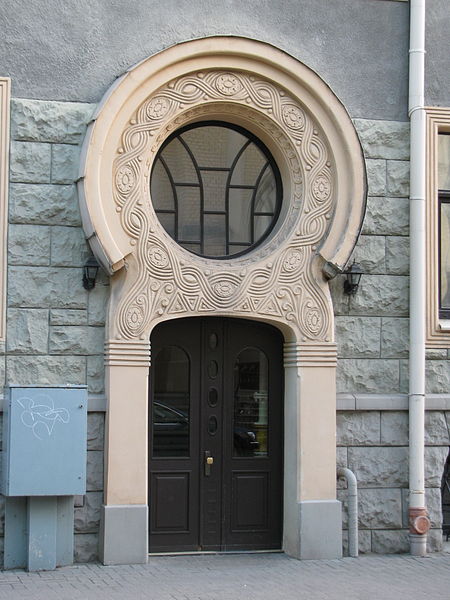Art Nouveau architecture in Riga
The Art Nouveau architecture in Riga makes up roughly one third of all the buildings in the centre of Riga, making Latvia's capital the city with the highest concentration of Art Nouveau architecture anywhere in the world. Built during a period of rapid economic growth, most of Riga's Art Nouveau buildings date from between 1904 and 1914. The style is most commonly represented in multi-storey apartment buildings. Stylistic influences derived not least from present-day Austria, Finland and Germany, while the establishment of a faculty of architecture in Riga in 1869 was instrumental in providing a local cadre of architects. This included, but was not limited to, some of the first formally trained ethnic Latvian architects. As elsewhere, the Art Nouveau movement in Riga was driven by a desire to express greater individuality, local attachment and a more rational kind of architecture than that which had dominated during the 19th century. Stylistically, the Art Nouveau architecture of Riga can be further divided into four different stages: Eclectic, Perpendicular, National Romantic; and Neo-Classical.

A good example of Riga's Art Nouveau architecture in its combination of rationality and decoration is this 1902 building on Smilšu iela 2 by Konstantīns Pēkšēns.
Eclectic Art Nouveau: A building on Alberta iela by Mikhail Eisenstein. Although a popular tourist destination, this very decorated kind of Art Nouveau is not typical for Riga.
Perpendicular Art Nouveau: The present Ministry of Education, built in 1911 by architect E. Friesendorff, has a so-called perpendicular facade with several sculptures by August Volz.
National Romantic Art Nouveau: Detail with typical National Romantic decoration on a house built in 1908 by Konstantīns Pēkšēns.
Vecrīga is the historical center and a neighbourhood of Riga, Latvia, located in the Central District on the east side of Daugava River. Vecrīga is famous for its old churches and cathedrals, such as Riga Cathedral and St. Peter's Church.
The Old Town of Riga
St. John's Church, Riga
The House of the Blackheads and Roland statue
Reconstructed section of the medieval city wall








